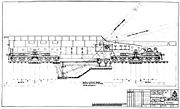
Span bolster
Encyclopedia

Rail terminology
Rail terminology is a form of technical terminology. The difference between the American term railroad and the international term railway is the most obvious difference in rail terminology...
, is a beam or frame used to link two trucks (US) or bogie
Bogie
A bogie is a wheeled wagon or trolley. In mechanics terms, a bogie is a chassis or framework carrying wheels, attached to a vehicle. It can be fixed in place, as on a cargo truck, mounted on a swivel, as on a railway carriage/car or locomotive, or sprung as in the suspension of a caterpillar...
s (UK
British English
British English, or English , is the broad term used to distinguish the forms of the English language used in the United Kingdom from forms used elsewhere...
) so that they can be articulated together and be joined to the locomotive
Locomotive
A locomotive is a railway vehicle that provides the motive power for a train. The word originates from the Latin loco – "from a place", ablative of locus, "place" + Medieval Latin motivus, "causing motion", and is a shortened form of the term locomotive engine, first used in the early 19th...
or railroad car
Railroad car
A railroad car or railway vehicle , also known as a bogie in Indian English, is a vehicle on a rail transport system that is used for the carrying of cargo or passengers. Cars can be coupled together into a train and hauled by one or more locomotives...
at one rotating mounting point. In effect, they make one "super-truck" out of the two, while still permitting each truck to move relative to the other.
The most common use on locomotives is to give a more flexible alternative to a four-axle truck; two two-axle trucks linked by a span bolster allows the wheels to follow a curve better, without excessive side forces or the need for lateral motion
Lateral motion device
Lateral motion devices permit the axles in some railroad locomotives to move sideways relative to the frame.-Purpose:The coupled driving wheels on steam locomotives were held in a straight line by the locomotive's frame...
of the axles in the truck. The use of a span bolster is normally signified in the AAR wheel arrangement
AAR wheel arrangement
The AAR wheel arrangement system is a method of classifying locomotive wheel arrangements that was developed by the Association of American Railroads. It is essentially a simplification of the European UIC classification, and it is widely used in North America to describe diesel and electric...
notation by a + sign; thus a locomotive with two span bolsters, each with two two-axle trucks (the most common arrangement) is a B+B-B+B.
Span bolsters have also been used for some high-capacity freight cars. The most common use is for large flatcar
Flatcar
A flatcar is a piece of railroad or railway rolling stock that consists of an open, flat deck on four or six wheels or a pair of trucks or bogies . The deck of the car can be wood or steel, and the sides of the deck can include pockets for stakes or tie-down points to secure loads...
s to haul large, heavy loads; these cars need large numbers of axles to spread the weight. Highly specialized Schnabel car
Schnabel car
A Schnabel car is a specialized type of railroad freight car. It is designed to carry heavy and oversized loads in such a way that the load itself makes up part of the car...
s with up to 72 total wheels have been built for carrying large heavy items. Often the span bolsters connecting the trucks are themselves connected by additional span bolsters to the car. The use of span-bolster-connected trucks is essential to allow the load to be transported through curves.

